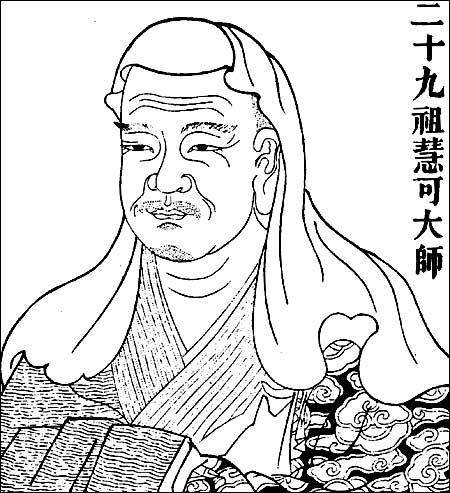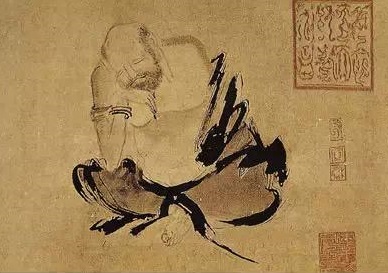Bodhidharma
Baizhang Huaihai
Caoshan Benji
Dahui Zonggao
Daman Hongren
Danxia Tianran
Dayi Daoxin
Dazhao Puji
Dazhu Huihai
Dazu Huike
Deshan Xuanjian
Dongshan Liangjie
Dōgen
Eisai
Guifeng Zongmi
Guishan Lingyou
Guizong Zhichang
Heze Shenhui
Hongzhi Zhengjue
Huangbo Xiyun
Huanglong Huinan
Huineng
Jinshan tanying
Linji Yixuan
Longtan Chongxin
Luohan Guichen
Mazu Daoyi
Nanquan Puyuan
Nanta Guangyong
Nanyang Huizhong
Nanyue Huairang
Niutou Farong
Qingliang Wenyi
Qingyuan Xingsi
Sengcan
Shishuang Chuyuan
Shitou Xiqian
Tianhuang Daowu
Xiangyan Zhixian
Xitang Zhizang
Xuansha Shibei
Xuedou Chongxian
Xuefeng Yicun
Yangqi Fanghui
Yangshan Huiji
Yantou Quanhuo
Yaoshan Weiyan
Yongjia Xuanjue
Yongming Yanshou
Yunmen Wenyan
Yunyan Tansheng
Yuquan Shenxiu
Zhaozhou Congshen
Index
Dazu Huike

born
487
died
593
died place
Yecheng, near Hebei
time
Southern and Northern Dynasty
ACHV
Second Patriarch of Chan
religion
Chan
POSTH name
Chan Master Dahong
teacher
Bodhidharma
students
Sengcan
works
《略说修道明心法要》
Contents
Biography
Bodhidharma legends
Teachings
Biography
Sources
As with most of the early Chán patriarchs, very little firm data is available about his life. The earliest extant biography of the Chán patriarchs is the Biographies of Eminent Monks (519) (Chinese: 高僧傳; pinyin: Gāo Sēng Zhuàn) and its sequel, Further Biographies of Eminent Monks (Chinese: 續高僧傳; pinyin: Xù Gāo Sēng Zhuàn; Japanese pronunciation: Zoku Kosoden) (645) by Tao-hsuan (?-667). The following biography is the traditional Chan biography as handed down throughout the centuries, including the Denkoroku by Zen Master Keizan Jokin (1268–1325).
Life
The Hsu kao-seng chuan says that Huike was born in Hu-lao (Sishui, modern Xingyang, Henan) and his secular name was Shénguāng (神光, Wade–Giles: Shen-kuang; Japanese: Shinko). A scholar in both Buddhist scriptures and classical Chinese texts, including Taoism, Huike was considered enlightened but criticised for not having a teacher. He met his teacher Bodhidharma at the Shaolin Monastery in 528 when he was about forty years old and studied with Bodhidharma for six years (some sources say four years, five years, or nine years).
Huike went to Yedu (Wade–Giles: Yeh-tu) (modern Henan) about 534 and, except for a period of political turmoil and Buddhist persecution in 574, lived in the area of Yedu and Wei (modern Hebei) for the rest of his life. It was during the time of upheaval that Huike sought refuge in the mountains near the Yangtze River and met Sengcan who was to become his successor and the Third Chinese Patriarch of Chan. In 579, Huike returned to Yedu and expounded the dharma, drawing large numbers to listen to his teachings and arousing the hostility of other Buddhist teachers, one of whom, Tao-heng, paid money to have Huike killed but Huike converted the would-be assassin. (ibid)
The Wudeng Huiyan (Compendium of Five Lamps) compiled by Dachuan Lingyin Puji (1179–1253) claims that Huike lived to the age of one hundred seven. He was buried about forty kilometres east northeast of Anyang City in Hebei Province. Later, the Tang Dynasty emperor De Zong gave Huike the honorific name Dazu ("Great Ancestor") Some traditions have it that Huike was executed after complaints about his teachings by influential Buddhist priests. One story says that blood did not flow from his decapitated body, but rather, a white milky substance flowed through his neck.
Bodhidharma legends

Five Dynasties, Shi Ke, "Huike thinking"
Cutting off his arm
Legend has it that Bodhidharma initially refused to teach Huike. Huike stood in the snow outside Bodhidharma's cave all night, until the snow reached his waist. In the morning Bodhidharma asked him why he was there. Huike replied that he wanted a teacher to "open the gate of the elixir of universal compassion to liberate all beings".
Bodhidharma refused, saying, "how can you hope for true religion with little virtue, little wisdom, a shallow heart, and an arrogant mind? It would just be a waste of effort."
Huike Offering His Arm to Bodhidharma (1496) by Sesshū
Finally, to prove his resolve, Huike cut off his left arm and presented it to the First Patriarch as a token of his sincerity. Bodhidharma then accepted him as a student, and changed his name from Shenguang to Huike, which means "Wisdom and Capacity".
Pacifying the mind
Huike said to Bodhidharma, "My mind is anxious. Please pacify it."
Bodhidharma replied, "Bring me your mind, and I will pacify it."
Huike said, "Although I've sought it, I cannot find it."
"There," Bodhidharma replied, "I have pacified your mind."
Awakening
According to the Denkoroku, when Huike and Bodhidharma were climbing up Few Houses Peak, Bodhidharma asked, "Where are we going?"
Huike replied, "Please go right ahead---that's it."
Bodhidharma retorted, "If you go right ahead, you cannot move a step."
Upon hearing these words, Huike was enlightened.
Transmission
Skin, flesh, bone, marrow
Legend has it that Bodhidharma wished to return to India and called together his disciples and the following exchange took place;
Bodhidharma asked, "Can each of you say something to demonstrate your understanding?"
Dao Fu stepped forward and said, "It is not bound by words and phrases, nor is it separate from words and phrases. This is the function of the Tao."
Bodhidharma: "You have attained my skin."
The nun Zong Chi stepped up and said, "It is like a glorious glimpse of the realm of Akshobhya Buddha. Seen once, it need not be seen again."
Bodhidharma: "You have attained my flesh."
Dao Yu said, "The four elements are all empty. The five skandhas are without actual existence. Not a single dharma can be grasped."
Bodhidharma: "You have attained my bones."
Finally, Huike came forth, bowed deeply in silence and stood up straight.
Bodhidharma said, "You have attained my marrow."
Bodhidharma passed on the symbolic robe and bowl of dharma succession to Huike and, some texts claim, a copy of the Lankavatara Sutra. Bodhidharma then either returned to India or died.
Teachings

Ming Dynasty, Dai Jin, "Picture of the Sixth Generation Patriarch of Bodhidharma to Huineng"
Dhyana
There is little doubt that Huike practiced and promoted meditation (as opposed to sutra commentary) as the method to reach understanding of true Buddhism. Tao-hsuan referred to Huike (and others) as dhyana masters (Wade–Giles: ch'an-shih; Japanese: zenji), highlighting the importance of meditation practice in these early years of Chan development. However, what form Huike and Bodhidharma's meditation took (which Tao-hsuan labelled ju shih an-hsin wei pi-kuan ("wall gazing" or "wall contemplation") is unclear.
Sudden awakening
One of the most important characteristics of the early Chán of Bodhidharma and Huike was the sudden approach to enlightenment rather than the Indian yogic meditation which advocated concentration and gradual self-perfection.
Huike wrote:
Originally deluded, one calls the mani-pearl a potsherd
Suddenly one is awakened---and it is [recognized] as a pearl
Ignorance and wisdom are identical, not different.
Lankavatara Sutra
There is some evidence that both Huike and Bodhidharma based their teachings on the Lankavatara Sutra, although this cannot be firmly established by modern scholars. Tao-hsuan listed Huike and his circle of disciples as masters of meditation, and the Lankavatara Sutra, in his Further Biographies of Eminent Monks (Chinese: 高僧傳; Wade–Giles: Hsu kao-seng chuan; Japanese pronunciation: Zoku kōsōden)
This sutra urges "self-enlightenment", the "forgetting of words and thoughts".
Two Entrances
One text that was circulating at the time of Huike was the Treatise on the Two Entrances and Four Practices (Wade–Giles: Erh-ju ssu-hsing lun; Pinyin: Erru sixing lun). This text was the purported teachings of Bodhidharma with a preface by T'an Lin (fl. 525-543)
The two entrances refers to the entrance of principle and the entrance of practice.
The entrance of principle is that one must have faith in the truth of the teachings and that everyone possesses the same "true nature" which is covered up by "false senses".
The entrance of practice refers to the four practices of the title: be undisturbed by suffering, accept one's circumstances and be unmoved by good or bad fortune, be without attachment or desire and, finally, govern one's actions based on understanding the emptiness or non-substantiality of all things.
Buddha-nature
Attached to the text are some letters, one of which may have been written to Huike and Huike's brief reply. The Bodhidharma text and Huike's letter indicate that the earliest teachings of what was to become Chan emphasized that Buddha Nature was within, and each person must realize this individually through meditation rather than studying the sutras, ceremonies, doing good deeds or worshiping the Buddhas. Meditation should be free of any dualism or attached goal and realization occurs suddenly.
Contact us
Disclaimer
Comments
© Copyright Jumpypixels.com